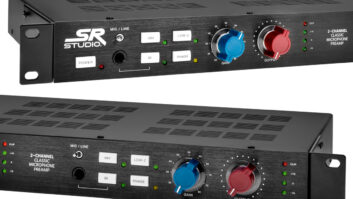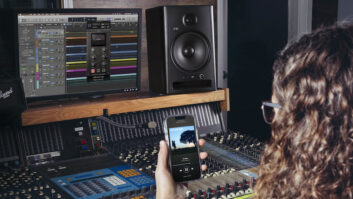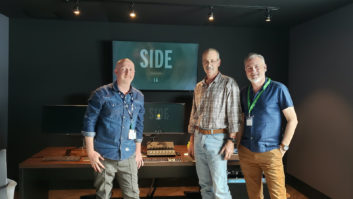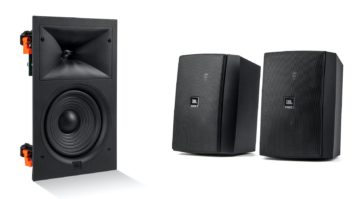Microphones are a key factor in achieving high quality recordings
and sound reproduction. Having access to top-notch equipment helps, but
more importantly, some knowledge about mic basics and a few simple tips
and tricks can make a substantial difference on your next project.
There are two common categories of mics used in professional audio.
Dynamic types operate when sound waves strike a diaphragm attached to a
coil of wire. When the coil moves within the magnetic structure of the
microphone, this creates an output voltage. The process is exactly the
reverse of the way a speaker operates. One variation of the dynamic
approach is the ribbon mic, which uses a thin ribbon of metal that is
placed between the poles of a magnet. Note that most ribbon mics are
bidirectional, meaning they pick sounds equally well from either side
of the mic.
Condenser mics use an electrically-charged, metallized diaphragm,
placed very close to a conductive back plate and separated by a thin
air layer. Sound waves striking the diaphragm cause a very small
voltage change, which is increased by a tiny amplifier circuit within
the mic body. As power is required by both the mic capsule and the
amplifier, condenser mics must have a power source, which can be a
battery inside the mic body or “phantom” power coming from either the
mixing console or an external power supply.
Dynamic mics tend to be extremely rugged, making them especially
well-suited for sound reinforcement applications. However, the
extremely thin, low-mass diaphragms used in condenser mics provide
improved high-frequency response, with better reproduction of fast
transient signals. Therefore, condenser mics are usually the best
choice for instruments such as piano, cymbals, and stringed
instruments.
With many instruments, two mics arranged as a stereo pair offer
optimal reproduction. One popular arrangement is the “X-Y”
configuration, where the capsules of two mics are spaced a few
centimeters apart, with the left mic pointed to the right and
vice-versa. Another stereo technique uses a “spaced pair”, with the two
mics placed parallel to each other and at least 50cm apart. The X-Y
method offers a stereo image that retains consistent level when the
recording is played in mono. The spaced pair technique provides a more
dramatic stereo effect, but extreme left and right sounds may be
emphasized more than sounds coming from the center. Both of these
stereo techniques are frequently used on stage and in the studio,
particularly for piano, orchestra, and above drum sets, large
percussion setups, vocal choirs and horn or string ensembles.
Acoustic guitars can be miked in a number of ways, and condenser
mics are best in this application. While a stereo X-Y pair works well,
some unconventional methods can offer good results. A miniature
condenser lavalier microphone can be taped or clipped inside the guitar
and mixed with a second mic placed outside the guitar, pointing toward
the soundhole. In a quiet studio, mics can be placed one or two meters
away, offering a full, mellow sound. If more string or pick noise is
desired, the mics can be placed closer.
Electric guitar speakers usually require no more than placing a
single dynamic mic pointed toward the cabinet. However, the sound of a
speaker varies widely when the mic is placed in different locations on
the speaker. Moving the mic even a few centimeters can make a major
difference, so it pays to experiment to find the “right” sound.
Generally, electric bass is not miked, but is usually connected to a
direct box. Sometimes, this direct sound can be combined with a mic
placed in front of the bass amp. In this case, the direct signal must
be delayed—usually 1-5 milliseconds—to align the phase
(timing) of the two signals.
As with electric bass, synths and electronic keyboards are usually
connected to direct boxes or routed from the submixer in the
keyboardist’s rack. One exception is the Leslie speaker connected to a
Hammond organ. Since the Leslie speaker consists of a bass speaker with
an rotating horn above, one upper and one lower mic are required. The
output of these can be mixed to provide a variety of effects, ranging
from subtle to dramatic, especially when the upper rotor is miked in
stereo, using two mics!
Acoustic grand piano can be a difficult instrument to reproduce,
where the microphone method depends largely on the other instruments in
the room. When recording solo piano, a stereo pair of mics is often
placed at a distance, to capture the room ambience. Unfortunately, this
approach doesn’t work well on stage with a rock and roll
band—here, close-miking is required. Depending on the piano, two
condenser mics in a variation of either spaced pair or X-Y generally
work well, with the lid raised open and the mic capsules placed 10-20cm
above the strings. A brighter sound results when the mics are placed
close to the strings. If sound leakage from other instruments is a
problem, then the lid can be (carefully) lowered, or a heavy blanket
can be placed over the piano top.
Most horn and reed instruments have a slightly harsh character and
sound better through ribbon or large-diaphragm dynamic or condenser
mics, especially at close distances. However, small diaphragm condenser
mics offer a little high frequency “edge” that can help solo
instruments stand out. Several companies—such as AKG, Audix and
Shure—manufacture miniature condenser mics with clamps for
mounting on saxophone or trumpet bells, and these are ideally suited
for wireless mic applications.
Drum and percussion miking presents a major challenge to any sound
engineer. These are extremely loud instruments that cover an
exceedingly wide frequency range, no to mention the fact that placing
mics within a maze of drum stands can be a difficult task, indeed.
Another problem is placing mics out of range of flailing sticks! As
mentioned earlier, an overhead stereo pair can be used to pick up
cymbals or to cover a large percussion setup. Condenser mics are the
best choice here, since they are placed out of harm’s way and offer
excellent high-frequency response.
Dynamic mics are most often used for snares, tom-toms, conga,
timbales, bongos and other drums—one secret to getting a good
sound here is to make sure that the mics are placed above the drum and
pointed downwards. When the microphone is placed parallel (or at a
slight angle) to the drum, then most of the sound energy strikes the
side of the mic, resulting in a thin, weak sound. If you do not have
enough mics (or console inputs) for each individual drum, then a single
mic can be placed between two adjacent drums.
Getting a solid bass drum sound can be tricky. Removing the front
head of the drum and placing a blanket or pillow against the beater
head may be the first step. Whatever you do, keep your condenser and
ribbon mics away from the bass drum, whose sound output can permanently
deform a delicate diaphragm! A large-diaphragm dynamic mic offers the
right combination of low-frequency response and the ability to
reproduce high sound pressure levels to do the job. A little EQ also
helps—a boost at 1.5kHz adds more attack, while a cut at
400-600Hz can reduce excessive boominess for a tighter sound.
Years ago, I became hooked on using electronic kick drum to trigger
samples on rock, pop and R&B dates—even when I was recording
an otherwise all-acoustic kit. This approach offer many advantages: As
the kick is silent in the studio, sympathetic snare buzz is greatly
reduced, and the overall signal in the overheads is cleaner, with less
kick bleeding into the other mics. Also, with no bleed from the
original kick, the kick patttern can be changed or altered later if
necessary—a highly desirable option. On any session (sampled or
otherwise), the goal of recording kick is to get a solid, consistent
sound—and here the sampled kick adds—rather than
detracts—from the drumkit sound.
Whether onstage or in the studio, getting a great sound requires
good equipment and the application of fundamental techniques. Remember
that there is no single correct method that works in all cases, and
sometimes a bit of experimenting with angles and microphone placement
really pays off. Be creative!
Note: This article first appeared in the Spanish language edition
of Mix magazine and has been translated to English from the
original.







